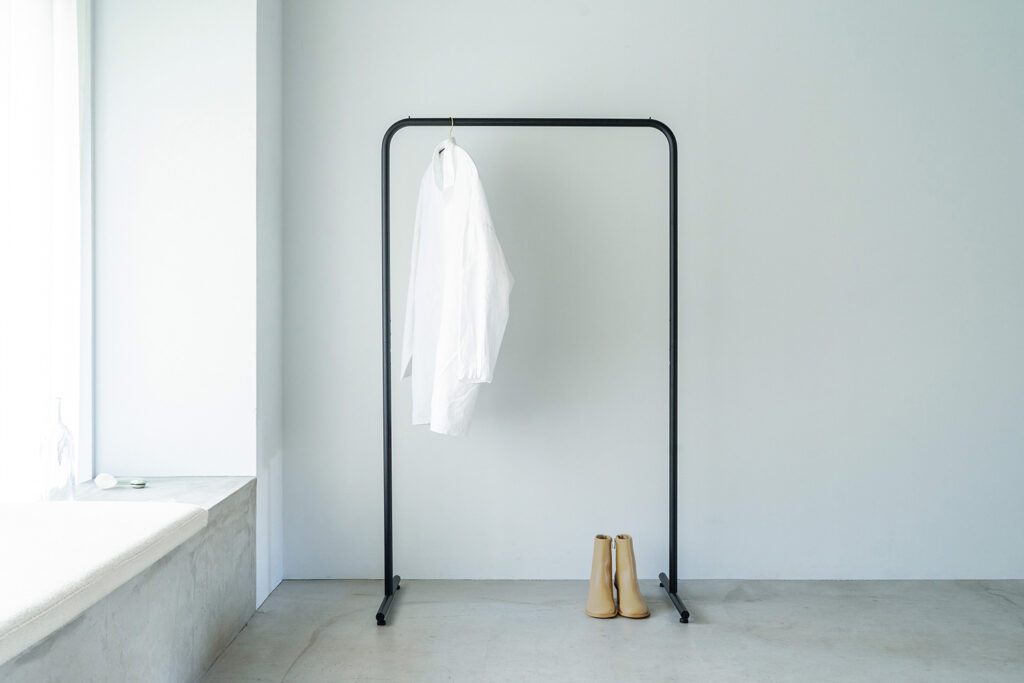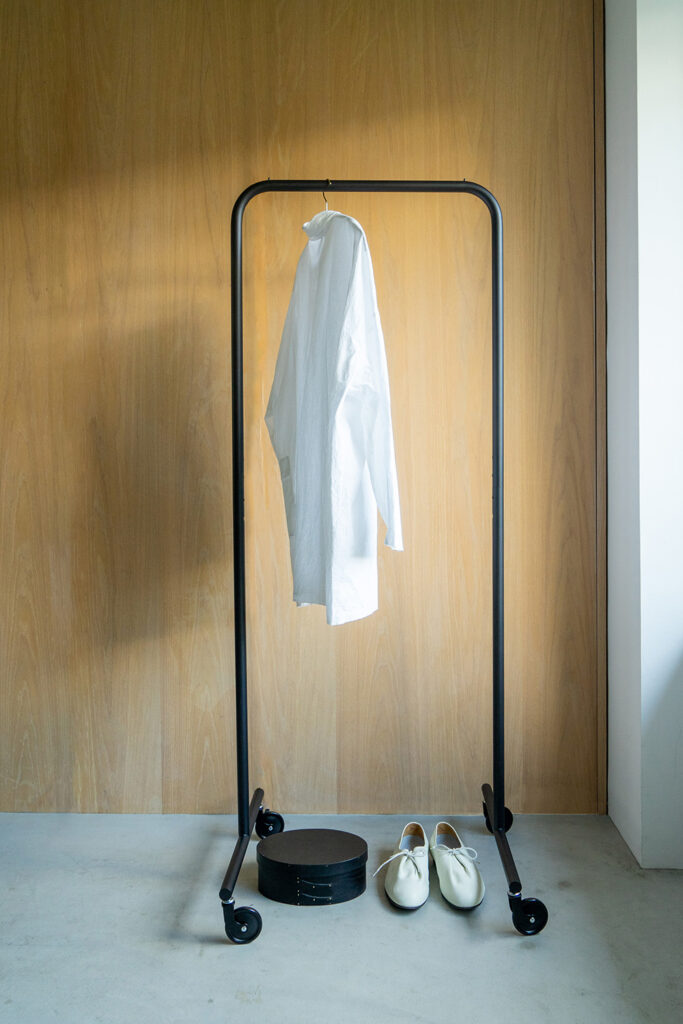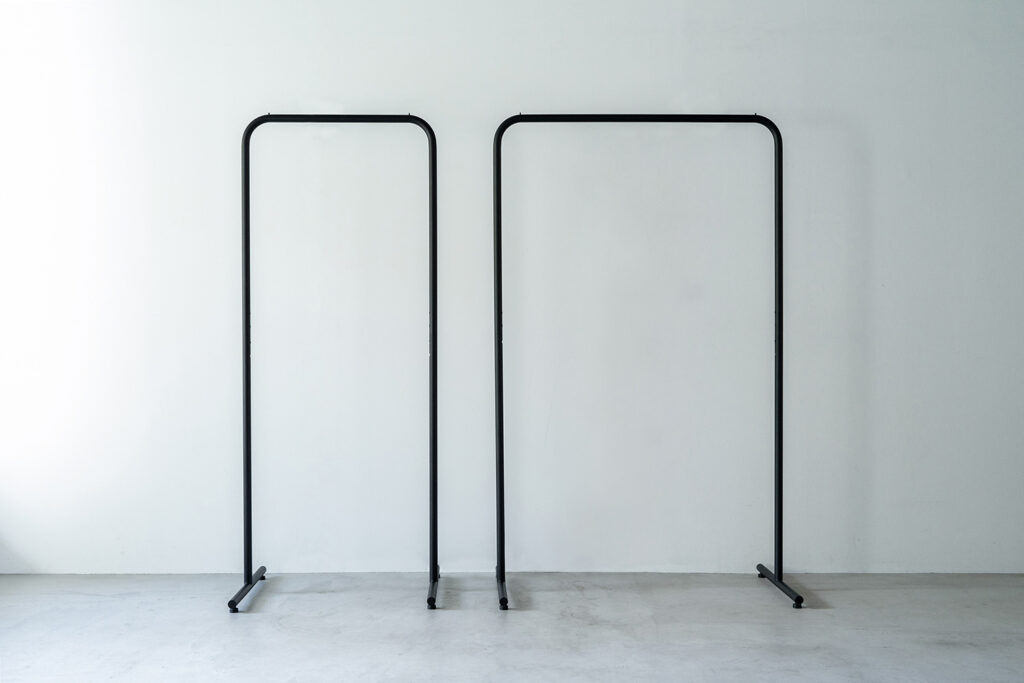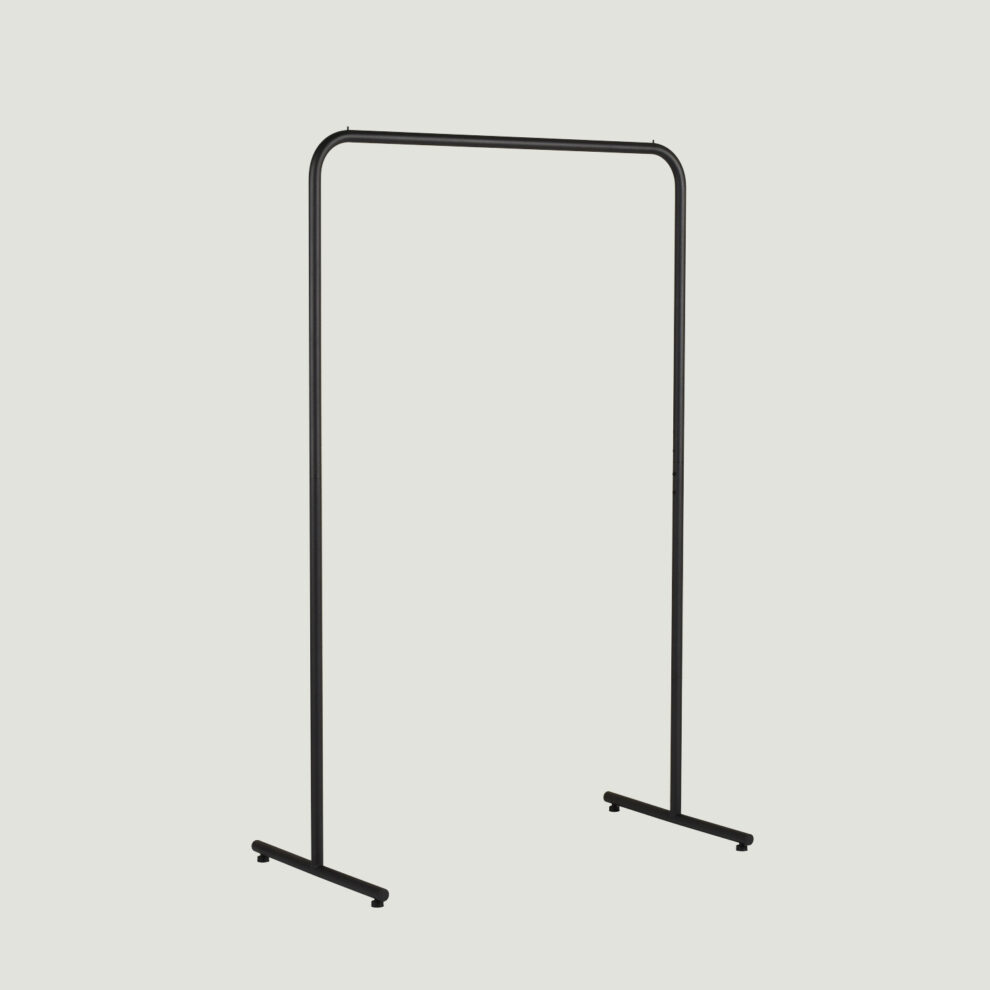HANGER RACK
This minimalism was thoroughly pursued to allow for more freedom in wardrobe styling, and the simple structure also cleared the difficulty of achieving both stability and strength.
Creative Director of MOHEIM, Shigeichiro Takeuchi talks about the STORIES of HANGER RACK.

Create your own interior design with your favorite clothes.
HANGER RACK, with its matte black steel piping, stands neatly and beautifully and blends naturally into your living space.
Its most distinctive feature is the absence of any horizontal piece connecting the legs.
Pursuing minimalism, HANGER RACK has a simple and calm design.
It can be used not only as a simple rack, but also as an interior item, allowing you to coordinate your space more freely than ever before.
PRODUCT STORY Vol.12
—— How did you come to develop HANGER RACK?
In the end, I have developed and realized the ideal hanger rack that I myself had envisioned. The first reason I wanted to make something like this is that the design does not interfere with the space in the room.

I wanted a hanger rack where long coats could be hung neatly, and where shoes, boots, and storage boxes could be placed at the foot of the rack, which led me to design this product.
—— What are the best features and what were the points you focused on?
As you can see, HANGER RACK does not have horizontal bars on the bottom. As mentioned earlier, we wanted to prioritize simplicity of appearance in order to realize a design that “does not disturb the space.” When you look at hanger racks on the market, it is common to find a horizontal penetration that connects upright frames somewhere at the bottom in order to maintain the load capacity and strength. However, MOHEIM’s HANGER RACK took on the challenge of removing that horizontal piece.
By achieving this design and structure, the rack blends seamlessly into the space when placed in a room. In addition, not only can long coats and other items be hung neatly, but the lack of horizontal bars allows for storage space at the foot of the rack for shoes, boxes, and other items. I think I was able to create a hanger rack that I myself would want.
As I mentioned in LINDEN BOX STORIES before, I think I could realize the idea of “NOT something that is ‘hidden’ out of sight, but something that looks good even when left out in the room and that you would want to ‘show off.’” I think we were able to achieve this with HANGER RACK as well.

—— What efforts were made in development to make this structure possible without the horizontal bars?
Without horizontal pieces, the challenge is how to ensure load-bearing capacity and stability. We solved this problem by using thick and strong steel pipes for the frame that would withstand a certain amount of weight.
And, in fact, there is one more point where we needed to be creative. That is the “direction” of the rack’s legs, which are at the bottom part of the rack that touches the floor.


The HANGER RACK is assembled from three frame parts: an upper part in the shape of an upturned U and a lower part with two legs. The disadvantage of the lack of horizontal penetrations connecting the lower part of the frame is that the legs will not be parallel to each other if assembled without thinking.
In particular, this HANGER RACK is a knockdown type, so the orientation of the legs can vary depending on how it is assembled. To allow adjustment of the opening of these legs, play was added to the bolt holes where the legs and upper frame are assembled and joined. This way, the user who assembles the product himself/herself can align each leg to be straight and parallel. We used this method, even though it is analog and simple.
—— The fact that HANGER RACK consists of only three frames also proves its minimalist nature.
The design and structure are so minimalistic that they can truly be described as “too simple.” However, if it were purely “simple,” the structure would have inevitably included horizontal penetrations. We were particular about eliminating that. That is why we were able to complete HANGER RACK, in which steel stands simply and does not make a statement, but smartly creates a space.
—— Casters can be attached on the feet.
A solid adjuster is attached to the feet by default, but casters (sold separately) are available as an option. The adjuster parts can be replaced with casters.

We were particular about these casters, and chose ones that both looked good and moved smoothly. Actually, they are the same casters used in TROLLEY, but we spent a great deal of time looking for the best ones when TROLLEY was developed. At the time, I chose casters that were “as minimalistic as possible, matching the color of the frame as well as moving smoothly,” and these casters were perfect for HANGER RACK as well. It is solid and large, yet sleek, and moves very smoothly. I think these casters will make it very easy to move the HANGER RACK, so it will be convenient to change the look of the room without trouble. They are also very useful when you have to clean the room.
—— How do you want people to use HANGER RACK?
The minimalist design is thoroughly stripped down to the bare essentials, making it ideal for apparel-related stores, exhibitions, and events, I think. As a store or exhibition fixture, it should serve as a classy and smart complement to the main attraction.

We would like HANGER RACK to be used not just as a storage tool, but as an item that adds color to interiors and spaces. By hanging your favorite shirts, jackets, coats, etc., you can “show them off” and achieve the interior coordination you prefer. As you can see in the photo, it goes well with the LINDEN BOX and can be used in any number of combinations.
Item information
